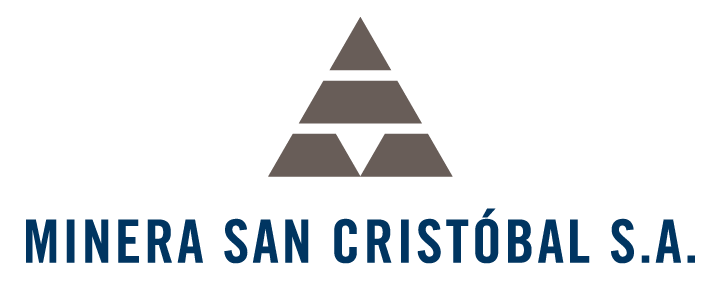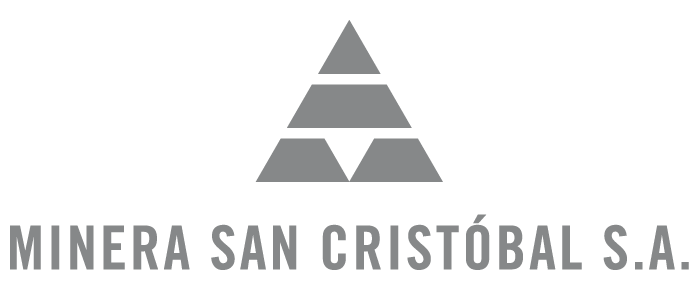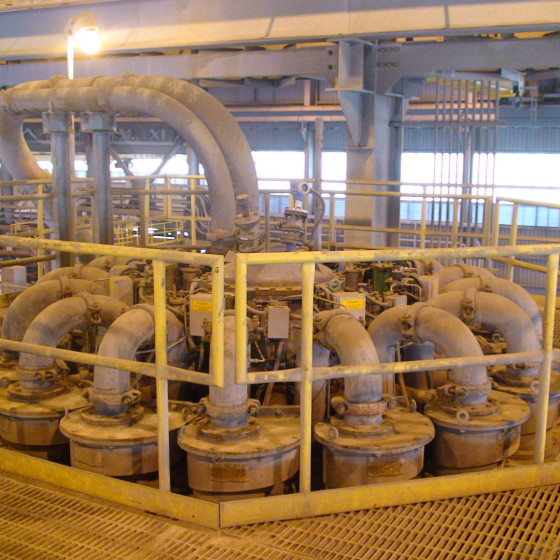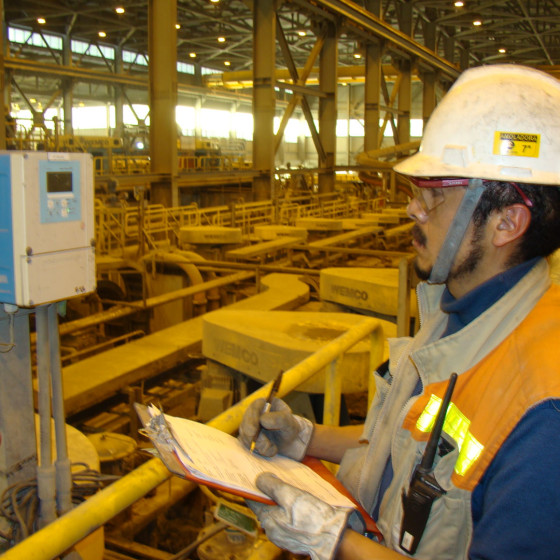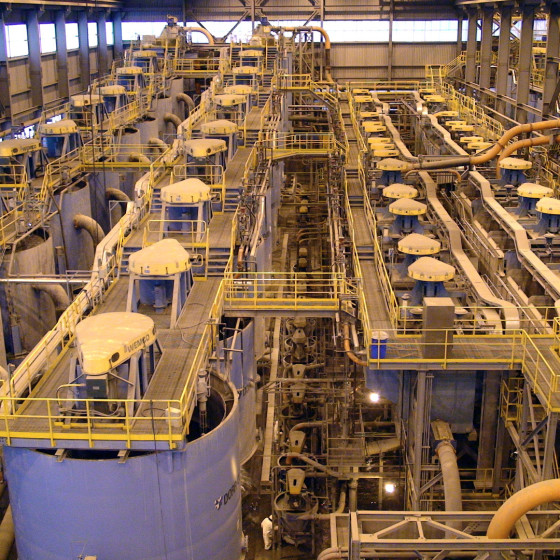Mineral Concentration Plant and Milling
The concentration of zinc, lead and silver in the mineralized rock extracted from the Jayula and Tesorera pits in the San Cristóbal mine is very low; it is therefore necessary to have the material undergo a process designed to increase the content of these elements and thus obtain products with a commercial value. In this sense, the concentration plant was designed to obtain two enriched concentrates.
The construction of the mineral concentration plant, which uses the flotation method, began in 2005. The plant started operating mid-2007. The plant has a nominal production capacity of approximately 52,000 tons of dry mineral per day. It operates 24/7/365, except on a few days scheduled for routine maintenance.
In order to optimize the work of the plant, an Expert System is used, i.e. a fuzzy logic based software to program operational rules in milling, flotation, thickening and other processes. Using adequate rules and fuzzification, this software can take control of the equipment with 24-hour continuous decision-making.
The minerals of value present in the ore body are in the form of sulfides and oxides. Only the sulfides can be processed in our flotation plant. Sulfides are minerals, the basic composition of which is sulfur combined with different metals — in this case zinc, lead and silver. Oxides are comprised of oxygen and metals. The plant’s outputs are zinc sulfide (sphalerite) and lead sulfide (galena). Silver sulfide (argentite) is contained in both products. The objective of our facility is to separate the lead and zinc sulfides from each other and from the non-usable remainder material through several phases of crushing, milling, and differential flotation, filtering and drying to obtain two enriched concentrates with a humidity of less than 10% ready for marketing.
To separate the sulfides from the sterile material, it is first necessary to reduce the size of the material to be treated until the sulfide particles are freed and can be separated from the remainder material. This is achieved in the crushing process, followed by the milling process.
Milling
Lime is added to the dry material taken from the stockpile in order to regulate the pH during the process.
This mixture enters the semi-autogenous grinding (SAG) mill, where the milling process begins. Inside the SAG mill (36 feet in diameter), the dry material is mixed with water during milling. The mixture of ground material and water is known as pulp.
The pulp from the SAG mill travels into a cylindrical sieve known as a trommel. The excess is recirculated again into the SAG mill via a conveyor belt system, and the undersized material is emptied into a box that feeds the ball mills to continue reducing the size for subsequent treatment.
The ball mills, each of which has a diameter of 22 feet, stand parallel to each other, forming two working lines. These operate in a closed circuit with two batteries of hydro cyclones, through which it is possible to divide the pulp into two sizes. The oversized material is sent back to the mills and the undersized material — with a diameter of 0.1 millimeter or less — is sent on to the flotation process.
Flotation, thickening and filtering processes
The flotation process begins when the pulp is loaded into special receptacles known as “flotation cells”, adding various chemical reagents and stirring the mixture.
Due to the characteristics of the mineral processed by this plant, the first process is conducted using lead flotation, followed by zinc flotation.
Pressurized air is introduced into the cell to create small bubbles in the pulp, to which adherence to the mineral particles to be selected is promoted as an effect of floating reagents, such as MIBC and F150, and modifying agents such as zinc oxide, sodium cyanide, sodium silicate and copper sulfate. In this way, the mineral is brought to the surface in the form of froth for subsequent withdrawal from the flotation cell. For lead flotation, Aerophine 3418A and Flotec 2200 LF are used. For zinc flotation, Danafloat 468 and Flotec 2041 are used.
These processes are performed in circuits of five serial cells each, with three products resulting from each circuit: “concentrates”, “middlings” and “tailings”. The concentrates go on to the thickening and filtering process. The middlings, from which it has not yet been possible to fully extract the mineral, go on to a re-milling and classification process, at which point the undersized material is sent to the flotation circuit for cleaning and re-cleaning, and the concentrate is finally extracted. The tailings are sent to the tailings thickener and from there to the tailings deposit.
Upon conclusion of the flotation process, the products obtained contain a high percentage of water and proceed to the thickening phase, where the solids (concentrates) are separated from the liquids (process water) in metallic circular tanks called thickeners.
The concentrates (zinc-silver and lead-silver) emerging from the thickeners are sent separately to the filtration area where water is extracted in two independent circuits equipped with horizontal press filters, and where the temperature is increased until the final humidity is under 10%. The product is concentrate ready for loading and railway transportation to the port.
The water recovered in this process is pumped to the flotation area and reused.
The process, from mine to market, takes approximately 40-75 days. From the mine to the plant is a short period of days, while the larger portion of time corresponds to time from the plant to port and then to the smelters.
The entire process is designed to maximize the economic yield of the company, minimize environmental impact, recycle resources wherever available, and apply world-class mining technology to the operation. Minera San Cristobal regularly reviews the process, with routine maintenance and quality control.
Energy and water consumption
Power consumption in a modern mine is extremely high. A processing plant of the size of that of Minera San Cristóbal could supply energy to a small city. Most of this energy is used in the milling circuit that represents 50% of the total consumption. Nevertheless, in San Cristóbal the mills are controlled by a system of high-tech sound. This system supports operation of the SAG mills at their maximum efficiency, listening to the mills. This system is not commonly used in the industry and, in fact, at the moment it is the most advanced system of this type in the world.
Using this system, MSC enhances efficiency of the mill by maintaining the optimization parameters at all times. This is translated into a power reduction of 10 to 15% in similar mills. This technology is applied in the ball mills as well, further reducing power consumption in a conservative way by an additional 15%. Keeping in mind that mills around the world use 3-5% of the world’s energy, the application of this technology in the industry may significantly alleviate the global demand for energy.
Water is becoming a problem in the mining industry more than ever before. It is therefore necessary to develop new technologies to reduce the demand and increase the recycling of water from mining. This has become a point of focus for many mining companies.
Minera San Cristóbal S.A. has been developing technologies to reduce the demand for low-quality water for many years. The first time the mine operations started, it was not possible to reach full capacity in view of problems with the availability of low-quality water for use in the process. This constraint forced the engineers to propose different ways to recover and use water recycled from the process.
One of the technologies used was the addition of a dilution tube to reduce the feeding of solid residues into the tailings thickener. This dilution guarantees the maximum possible yield of the thickener and a reduction of the demand for low-quality water. At present, 80% of the water used in San Cristóbal is recycled. As a result of this improvement in performance, the demand for low-quality water fell to 50%.
The development and implementation of these two technologies have helped Minera San Cristóbal S.A. be at the vanguard of the technology to save energy and water, which in turn helps ensure future sustainability of the mine.
Below is a link to a statement made by Ivan Adair, CEO of CRC Ore, a consortium of the Australian government entrusted with disseminating the technology for the mining industry. This group is very much aware of the need for technological advances in the mining industry and is a leader of technical know-how in the industry.
“The access to water is increasingly problematic for new and already existing operations in the mining industry. Investments in desalination plants may cost Chile’s mining industry around USD 13 billion.”
The technology of the dilution tube developed by Minera San Cristóbal S.A. is an elegant and extremely effective way to significantly increase the recovery of water in mines. The innovation was developed and tested in MSC’s operation in Bolivia.
Over the last eighteen months, this technology has allowed for a change in water recovery and management in this operation. Thanks to the successful implementation, it has been possible as well to avoid the need for finding an additional source and exploiting additional water resources for the work of expansion of the mill.
The technology is easy to install, maintain and operate – in fact, it can be put in place in a single shift. The additional benefits include the proactive control of the density of feeding into the thickener and important savings in consumption and therefore in the cost of flocculants. Future efforts will focus on the installation and evaluation of its effectiveness in other operations, along with an exploration of possible synergies with other existing technologies for eduction in thickening agents.
It is a credit and a great achievement for the team of Minera San Cristóbal S.A. that has conceived and implemented this technology in such a short period of time. Its demonstrable impact bears witness to the combination of creative thinking and practice in engineering in a remote location – necessity really is the mother of invention”.
